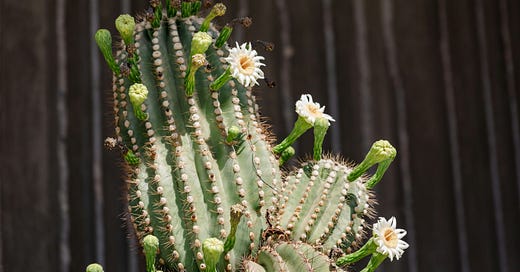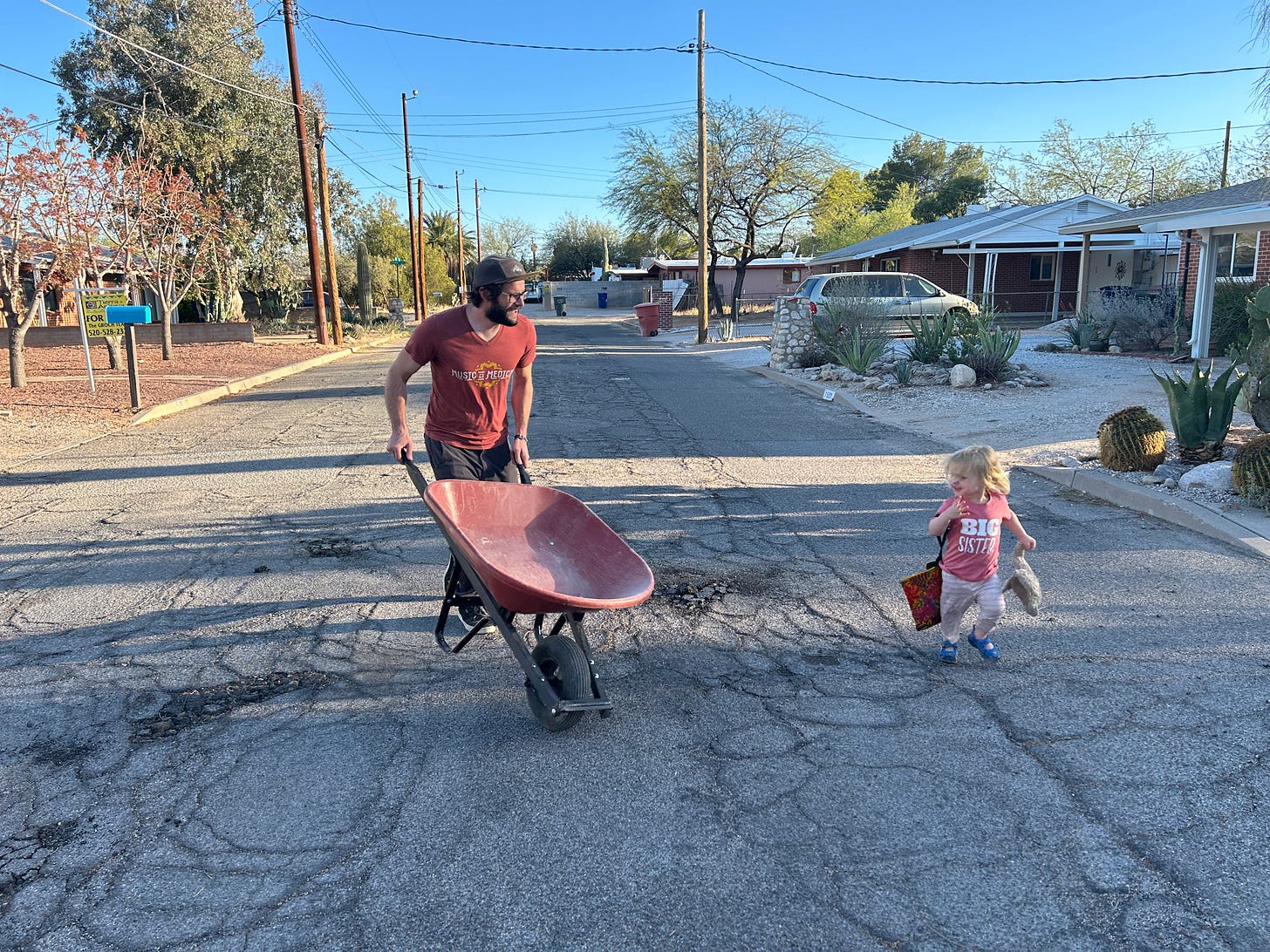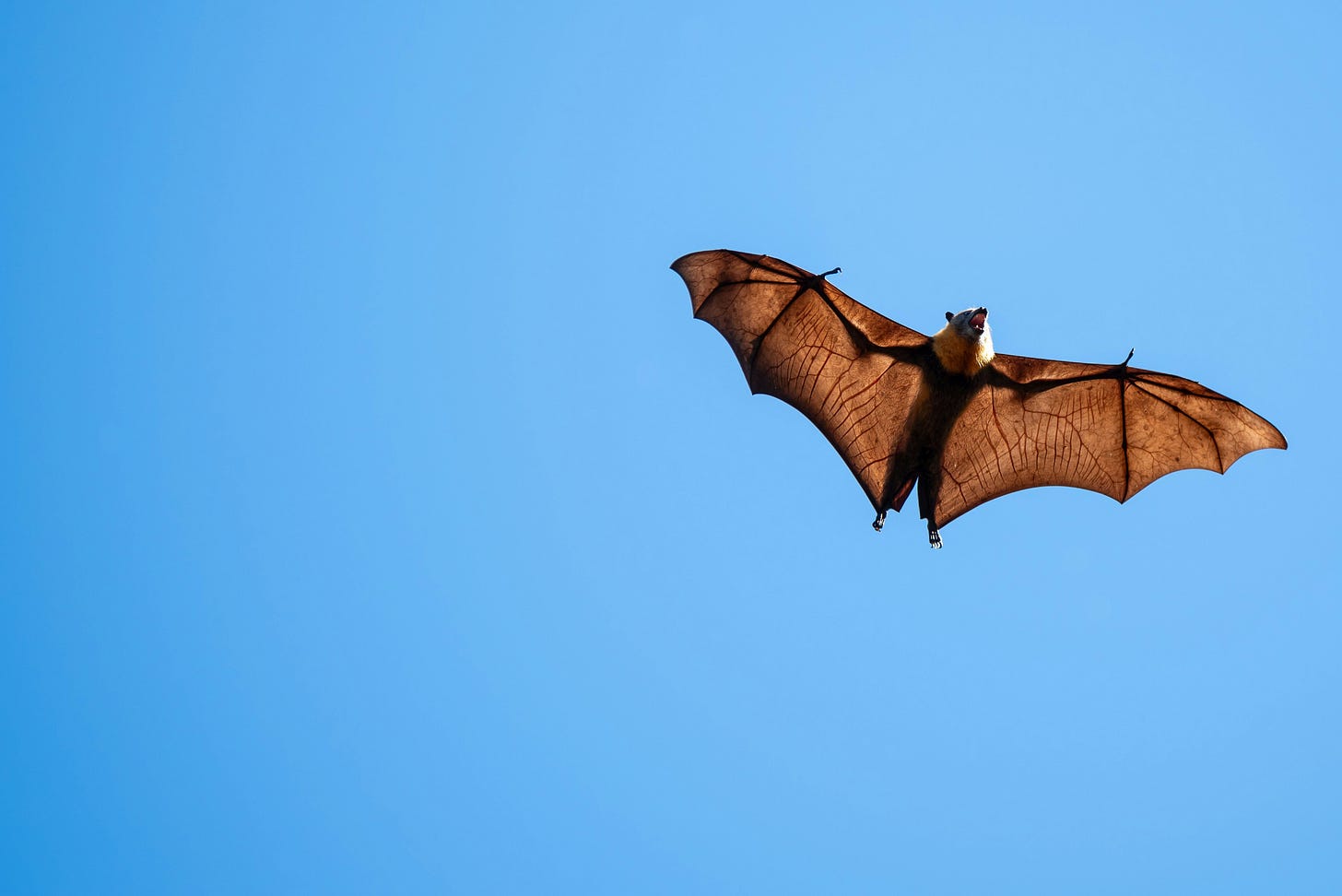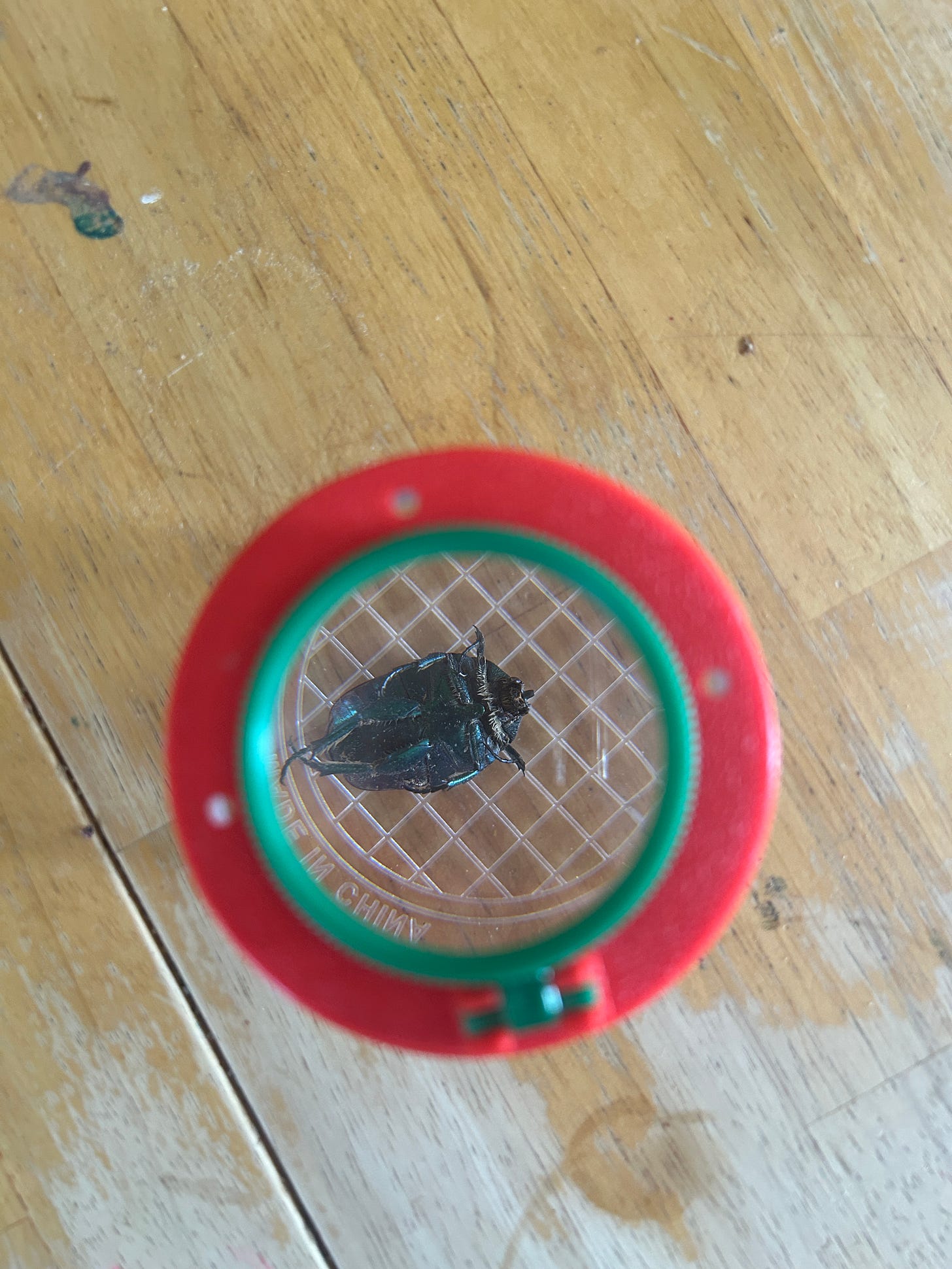What Do Newborn Desert Eyes See?
Learning to see and be seen in color, both in the world around and the world within
Mother One Another is nearing its year and a half of existence! These weekly musings have been such a joy to be able to research, create and share with you. They dive into questions like: Why does the earth smell the way it does after rain? What small actions are significant in this time of polycrisis? How do I want to mother myself, and my loved ones, without losing myself? I have always seen mothering/nurturing, the natural world, and community care as woven. If you are able to, consider updating your subscription to $5 a month, or an annual subscription, to be a patron of these works. Or like them, share them, and let me know what you think! I love your comments. Thanks for being along for the journey.
The author comes up to me, or rather, to my baby bundled up in a rainbow wrap.
“How wonderful you brought a baby to the book reading!” He exclaims, and I feel a rush of tender appreciation. Noticing. I tell the author that my son’s name, Wren Petrichor, is one he might find particularly interesting. Gary Paul Nabhan, an ethnobotanist who has written dozens of books on everything from love affairs with mesquite trees to cultural resistance in the southwest, loves petrichor. One of his first books, The Desert Smells Like Rain, is where I learned about the fascinating chemical compound- geosmin- that, when mixed with water, releases the aroma of petrichor: the divine smell of earthiness after rainfall.
Nabhan proceeds to open up his book talk by talking about none other than petrichor, and a new finding that geosmin has been identified on the flowers of saguaros. So when the saguaros bloom right now- those creamy white muffins opening up atop the long, sagey limbs- they are emitting the same smell as the earth after the rainfall, the beckoning of the creosote leaves when damp. My son is tethered to saguaro flowers.
Photo by Jeremy Alford on Unsplash
At the end of his talk, Nabhan asks, of course, for questions. And this is where my heart races. There is a part of me that wants to ask a question- or many, to be honest. I want to ask how he makes time to write so prolifically, especially back when he had kids. Who is his current plant or person mentor at this stage of elderhood? I want to ask about cultural differences and navigating deep disagreements on world views when working with indigenous communities and not being indigenous. But instead, I sit there, heart throbbing, as a few other questions are asked.
“Any more?” He says. The silence hovers. I stay tucked within my cocoon with Wren. He’s sleeping on my chest, and I am still hibernating in my own way. This outing, visiting a tiny, local book store for this reading, is one of only a handful of social ventures I’ve been on, and while part of me wants to open my mouth, speak, share, learn, be noticed, another part of me cannot do so.
I’m breastfeeding later as he’s leaving the store, and he nods my way, saying once again, “Thanks for bringing the baby.” This time, I find myself wanting to retaliate. I want to tell him that I, too, am important! I’m the one who brought this baby into the world, let alone this book store. And I also write! I have questions– I just didn’t ask them because I’m tired, and insular, and nervous. Also, I’m an educator. And I write about trees and interconnectedness and change and hope and mothering one another and ourselves. I’m a curious being, and I, I, I…I want to be seen.
I’m not sure how many of you can relate with this seemingly universal feeling- a desire to be seen for who we really are, and who we are becoming, not just one color of ourselves. Sometimes, this potency wells up within me- a desire for someone to see me for all I am, the vastness, the multitudes contained (as Walt Whitman famously said). And while I do have many people in my world who are my witnesses- my partner and close friends and family members- there is something to wanting to be witnessed by someone you admire. Wanting to be seen not just as one thing (the mother carrying a baby) but as so much deeper, so much wider.
My therapist would tell me that my desire to be seen by others is ultimately my desire to be seen by myself.
My favorite expression of my 2-year-old’s is “see you,” or “see me.” As in: “See me mama!” or “I see you!” or “See me running!” Alia uses see in almost every paragraph she is now patch-working together. And each time she says this seemingly mundane verb, I believe that she can, and is, seeing deeper within me.
“Mama see me running” as we do a community action project in our neighborhood
“I see you.” It’s such a simple statement, such a profound longing that threads between seasons of living. I still hold that she is tethered to the world of spirits, one big toe planted on that sacred ground. When she says “I see you,” some part of her sees all of me- who I’ve been in past lives, my intentions, my woundings, my heavy-bodied hopes on frantic wings. I believe she sees my shape, my song, my smell; sees me as her mother and more. Sees me as I see myself.
My 7-week-old is watching me write from his rocking chair. Alert, he stares and furrows his eyebrows at the world. He has started smiling more in these last 2 weeks- this spontaneous bloom of a flower on his lips, open and wanting and wonder-filled. He crinkles his stormy blue eyes at me right now. How much of me can he see?
When a baby is born, they can only see the world in black, white, shades of gray. Their vision focuses on objects 8 to 12 inches away: the distance to a parent’s face, to a breast and a nipple. During months 2 to 4, babies can begin to track movements and recognize parents’ faces, slowly seeing more color and focusing on depth. At 6 months, babies can see just like you and me– the palette of colors, the close and the far, the moving and the still.
Perhaps, when he sees me now with eyes almost 8 weeks old, I am beginning to be colored in. A dollop of pink on my lips, the muddy green of my eyes, the hay brown of my hair. What is it like to watch color become color? There was a time for me, as a newborn, that I experienced this shift. Can I recall what it felt like within me- to see not just what is in front of me, but suddenly (or slowly?) another layer, another depth, another perspective?
15 years ago, one of my 6th graders in my first year teaching asked me, “Miss…did this story happen back when the world was black and white?” She firmly believed the 1960s was a time devoid of color.
Color, in and of itself, is more than we can understand.
The mantis shrimp has 12 photoreceptors, whereas we humans only have 3. They can see ultraviolet and polarized light, colors we don’t even know to be colors. A bee can see ultraviolet runways, patterned lines on the flowers that guide their flying bodies straight to an airport of nectar.
Frank, my husband, tells me that when he finally got glasses at the tender age of a 4th grader- circular gold-rimmed spectacles that I imagine made him look like the cutest, tiniest grandfather- the world snapped into focus. The tree leaves became individuals. The boundaries of color greeted him. The waves of chalk upon the board filed themselves into proper sentinels of letters. He could see anew.
A student of mine who is blind once told me that blind people are superheroes because of their enhanced abilities to hear. She talked about how she, like a bat, can echolocate- identify exactly where an object is in a room by listening to how the waves bounce off one another. She told me of one famous blind person who could echolocate so perfectly, he could find a quarter resting on the floor.
Photo by Graham Holtshausen on Unsplash
As I was breastfeeding at the end of the book talk, before Nabhan said his pseudo goodbye, an elder I know just a little came up and joined me in my gentle cave. She told me how she loves to adorn herself in color. It was true, as we talked her outfit was a garden of blooms with a bright, red bra strap peeking out on her shoulder.
“That’s why,” she said, “I don’t see any beauty in the desert right now. I don’t see any color.”
Perhaps you need to learn to see the colors differently, I suggest, but I know this is easier said than done. She is of a watery and forest landscape, the same where I grew up. It is hard to see the blues of mountains when you are used to seeing the blue of Lake Michigan.
And yet, when I drive home from the event, I see green trees yellow and yellow trees green. Purple-pink blossoms are springing out of gray trees. This season, foresummer, is a time I have learned to see the desert vibrantly, but it wasn’t always so. 18-year-old me didn’t see color here either. It took leaving and returning, slowing down my pace and getting familiar with the flower petals and names of the trees, to begin to understand this landscape. My desert eyes were a newborn’s. They’ve only recently begun to see rainbows.
In reflecting on all the ways we do and don’t see, I greet the shades of myself- the various me’s who want to be known by the world. Yet I hold that I cannot control how any other sees me, just as I cannot control how someone sees brown in this valley where I now see green. Our perspectives are always shifting, our eyes growing new abilities.
Nabhan said that one of the gifts of Tucson is our “creative conflicts.” Because of how many different cultures, different perspectives there are in this borderland city, we can never and will never see something in the same way. “And we are better for it,” he adds. The differences sharpen us, challenge us, carve us out humbly and ask us to consider something we thought we knew, we thought we saw fully, with an entirely new lens.
“Mama, see me,” Alia ran into my room this morning as I attempted to get a few more minutes of sleep, the baby curled in the crook of my arm. “Mama, see this!” She has brought me a dead beetle in a her new magnifying insect collecting jar, a gift from her Pop Pop who is visiting us from the forests of Delaware. I see her curiosity; I see her love for nature; I see her tactile way of interacting with the world. I look at the insect, frozen into the dark shape of death.
“It’s geen!” she says, “so geen!” And where I’d seen only a black beetle, she has already shown me differently.
Breakfast in bed: beetles








